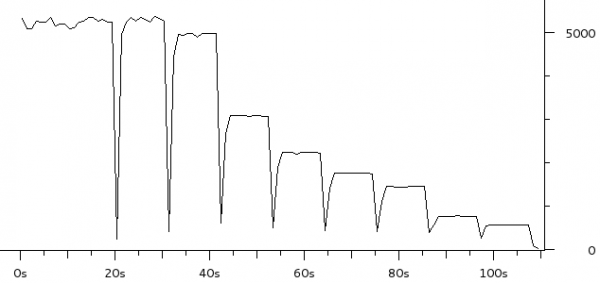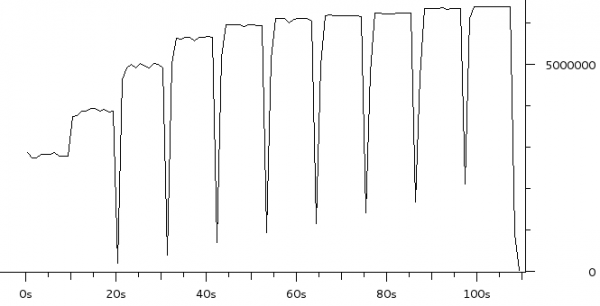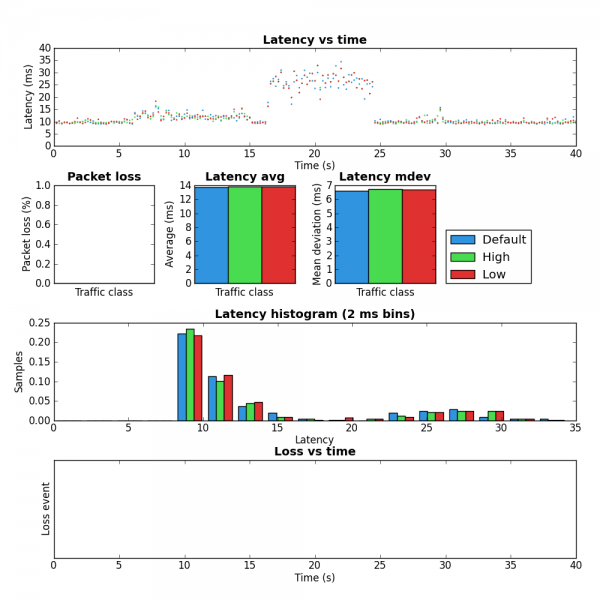http://www.mindvalleyinsights.com/7-lessons-from-building-a-lifestyle-business/
Dan Siemon
2012-12-25
An introduction to SDN
An Ender’s Game movie?
Per packet overhead on VDSL2 – part 3
Previous instalments:
For tonight’s edition I have increased the number of small packet sizes in the experiment and dropped the larger sizes. For each of the following data sizes (iperf -l) there are five seconds of traffic: 0, 10, 20, 30, 40, 50, 60, 70, 80, 90, 100, 110, 120, 130, 140, 150, 160, 170, 180, 190, 200, 210, 220, 230, 240, 250, 260, 270, 280, 290 and 300 bytes.
For data sizes of up to 90 bytes the packet per second value is pretty much constant. Alex Burr offered a theory on the Bufferbloat list that I may be hitting a packet rate limitation. If I understand properly, the above chart seems to support this.
From the bitrate perspective, the curve flattens around 90 bytes of data as well.
Per packet overhead on VDSL2 – part 2
A few days ago I wrote about some interesting latency results I observed on my home Internet connection with small packets. This post adds a bit more data.
In this experiment I disabled all upstream traffic shaping and then used iperf to blast UDP packets of various sizes to a destination host I control. The transmitted rate was 10Mbps and the upstream link rate is ~6.5Mbps. On the destination I captured the packets with tcpdump and generated the charts below with Wireshark.
The charts show ten sub-experiments – 10 seconds of traffic for each data size (iperf -l): 25, 50, 75, 100, 200, 300, 400, 500, 1000, 1400 bytes. T0 is when the first packet is received.
The first chart shows the packets per second received at the destination. Not surprisingly, the packet rate is much higher with small packets.
The second chart shows the bitrate observed at the destination. Notice that for small packets the effective bitrate is much lower. This seems to support the theory that this link has a lot of per-packet overhead.
Neat (and scary) infographic – New York CO2 emissions
Per packet overhead on VDSL2
My home router (Linux box) is configured to shape upstream traffic to just below the link rate to avoid Bufferbloat – this greatly improves interactive performance under load. Recently I’ve experimented with various packet sizes. The charts below show the effect of small packets.
- Between 0-6 seconds the link is idle.
- From 6-14 seconds the upstream link is flooded with 1,400 byte packets (10Mb/sec of traffic trying to get through a 6.2Mb link)
- At 17 seconds the upstream link is flooded with 64 byte packets (10Mb/sec as well)
Notice how much higher the latency and jitter are with small packets.
Confusingly, these results were gathered with the bandwidth shaper configured for 53 bytes of overhead [1] which is my current understanding of the per-packet overhead on VDSL2 [53 is a coincidence with the ATM cell size].
Per-packet overhead for VDSL2 (without ATM) and PPPoE:
- 5 Bytes for PTM
- 40 bytes for 802.3
- 8 bytes for PPPoE
Either the above overhead numbers or wrong or there is something else going on.
[1] – overhead argument to tc.




